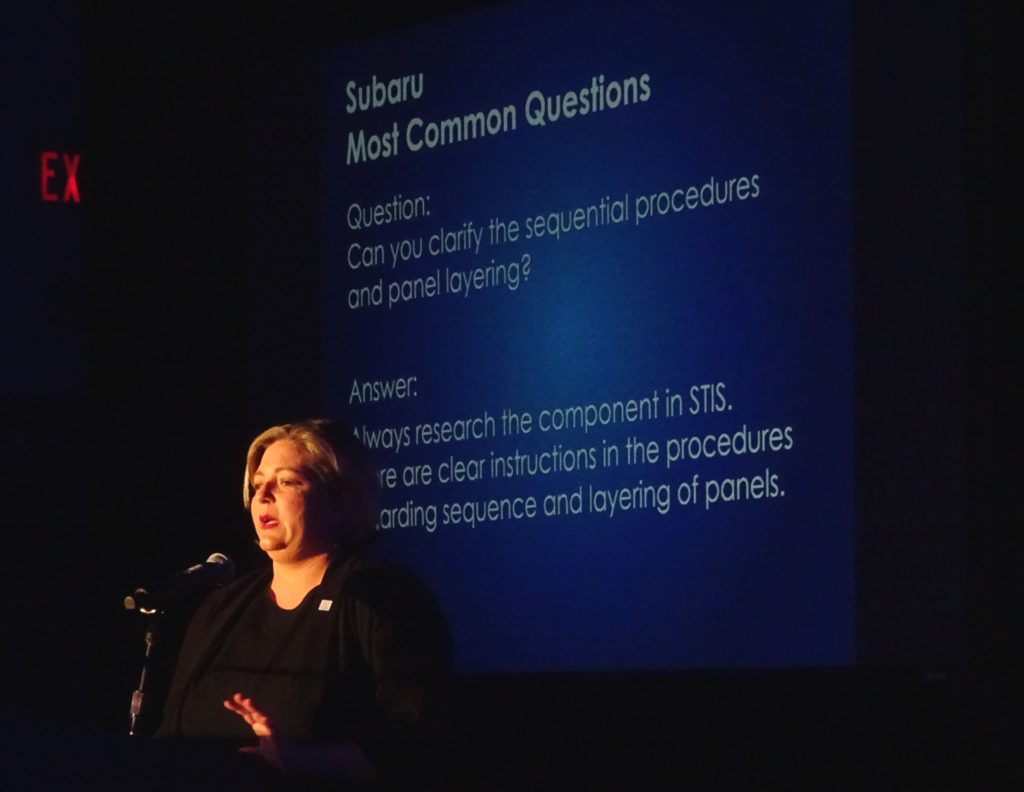
Inspections truly required after every collision, and other Subaru answers to shop FAQs
By onAnnouncements | Education | Repair Operations | Technology
Subaru wholesale parts specialist Nicole Riedel confirmed this month that Subaru demands safety inspections such as steering column measuring after all repairs.
To the “three million of you” who emailed Subaru about this point, that’s the answer, Riedel told the Nov. 7 SCRS OEM Collision Repair Technology Summit at SEMA.
If you’re working on a vehicle that had its side-view mirror clipped off, “you still have to do it,” she said.
She asked the audience to say it with her: “Every single time.”
She said Subaru of America was working with Subaru headquarters in Japan on getting more clarity. But as of now, “please stick with the repair procedures,” she said.
“Safety is paramount for Subaru,” a slide stated regarding the post-repair safety inspection issue. “We need all of our repairers to adhere to the STIS repair procedures. Currently, ALL repairs must undergo the Post Repair Safety Inspection, regardless of severity. The steering wheel measurement is part of the post collision inspection and must be removed per STIS.” (Emphasis Subaru’s.)
I-CAR in 2018 reported receiving a similar answer from Subaru.
“Recently we had a technical inquiry that asked, ‘Does the steering column require inspection after any type of collision, regardless if the airbag deployed?’ I-CAR wrote last year. It continued:
Our contact at Subaru stated, “Per the vehicle service manual, if the vehicle is involved in a collision, even if it is a slight collision, be sure to check the following systems. The steering column is one of the systems.” He goes on further to state that “All SUBARU vehicles need to to have their steering column checked. There are NO specific circumstances where the inspection would not be required.”
It is also important to note that part of checking the steering system also involves checking the “deflection of front and rear, upward and downward directions, and mounting condition to vehicle body of the column assembly ‐ steering.”
Panel layering
The steering column measurement question was among the answers Riedel presented Nov. 7 to inquiries her OEM received from auto body shops.
Another common question to Subaru involves panel layering and the sequential process, according to Riedel’s presentation.
She said Subaru built the frame in a “very specific” manner. While it might seem easy to peel up a panel and return it, “please do not do that.”
The shop would be compromising crashworthiness, she said.
“Always research the component in STIS,” a slide stated on this point. “There are clear instructions in the procedures regarding sequence and layering of panels.”
Touching a module
According to another slide, a body shop had sought clarification on modules and when they needed to be replaced. She said Subaru of America contacted headquarters in Japan, and they said “‘yes, indeed.'” The module is so precisely calibrated that it must be replaced if touched, Subaru Japan confirmed.
Subaru of America was hoping it could tell repairers something different, but “there’s obviously a really specific and important reason for doing that,” Riedel said. So if the instructions call for replacement after any touching of the module, follow them, she said.
Subaru websites
Riedel also walked the audience through technical resources available for body shops.
In terms of repair procedures, the STIS website can be found at techinfo.subaru.com. The OEM encourages shops to access it with the latest Internet Explorer browser. (Rather than Firefox, Chrome, Safari, etc.)
“This site is optimized for Internet Explorer; we highly recommend using Internet Explorer version 11 or above for the best experience,” Subaru states on the site.
One of Riedel’s slides said shops will also need a PDF viewer and JavaScript and temporary cookies enabled to use the side. It also recommended a screen resolution of at least 1024 x 768.
Subscriptions start at $34.95 for three days. (Riedel said Subaru thinks a one-day subscription would be insufficient) They are free for certified Subaru shops.
Other resources include www.subaruparts.com, Subaru’s parts website.
Subaru special tools can be ordered from https://subaru.service-solutions.com., and a list of what’s needed for certification can be found on the Entegral website or by emailing certifiedcollisionsupport@subaru.com. (Moderator Mike Anderson, CEO of Collision Advice, encouraged every shop to check and update their Entegral profile. Any collision repair professional will have a profile on the Enterprise-affiliated site, he said.)
Riedel said that even a shop doesn’t plan to be certified, “if you see one Subaru,” look at the list of equipment required for certified shops. Make sure you have the special tools “at least for the safety systems” to make sure you are fixing the car right, she said.
Finally, owner’s manuals can be read at www.Subaru.com/owners/index.html. According to Riedel, “our owners read this for fun” and contact the company with typos.
Correction: An earlier version of this article misspelled Subaru wholesale parts specialist Nicole Riedel’s name. The article has since been updated to address this.
More information:
Images:
Subaru wholesale parts specialist Nicole Riedel confirmed Nov. 7, 2019, at the SCRS OEM Collision Repair Technology Summit that Subaru demands safety inspections such as steering column measuring after all repairs. (John Huetter/Repairer Driven News)
Subaru wholesale parts specialist Nicole Riedel discussed following OEM procedures on panel layering Nov. 7, 2019, at the SCRS OEM Collision Repair Technology Summit. (John Huetter/Repairer Driven News)

